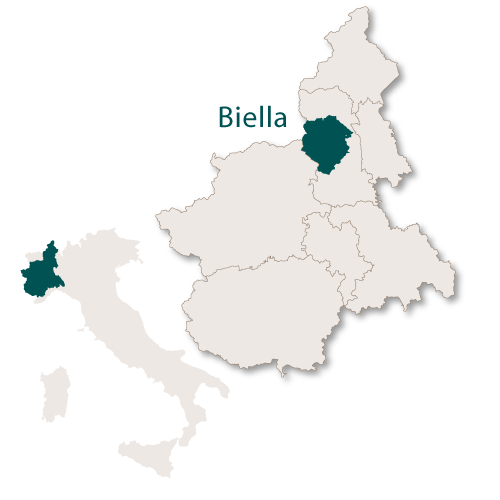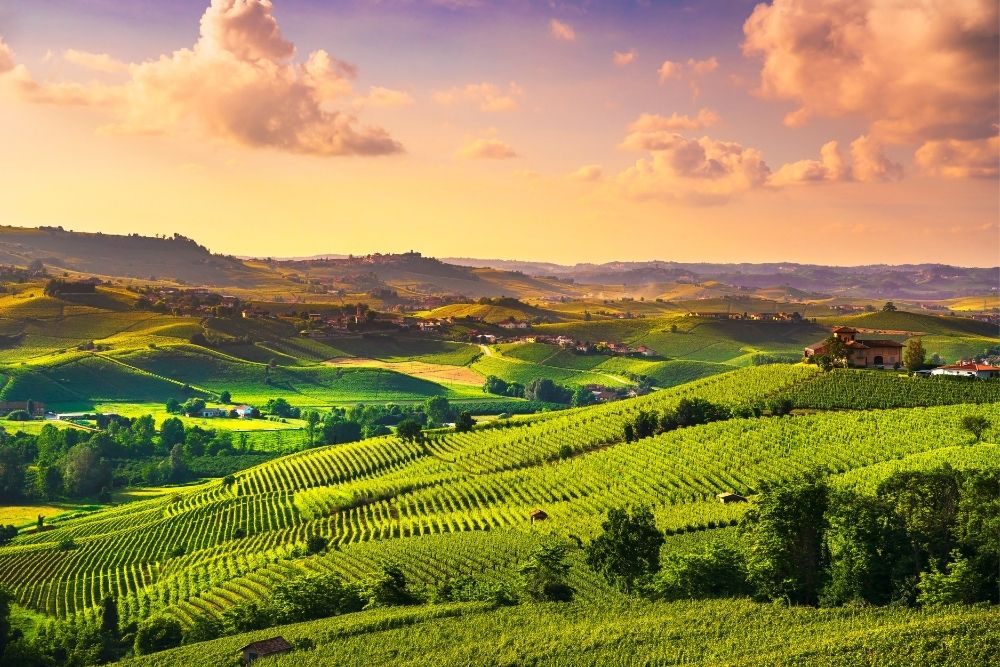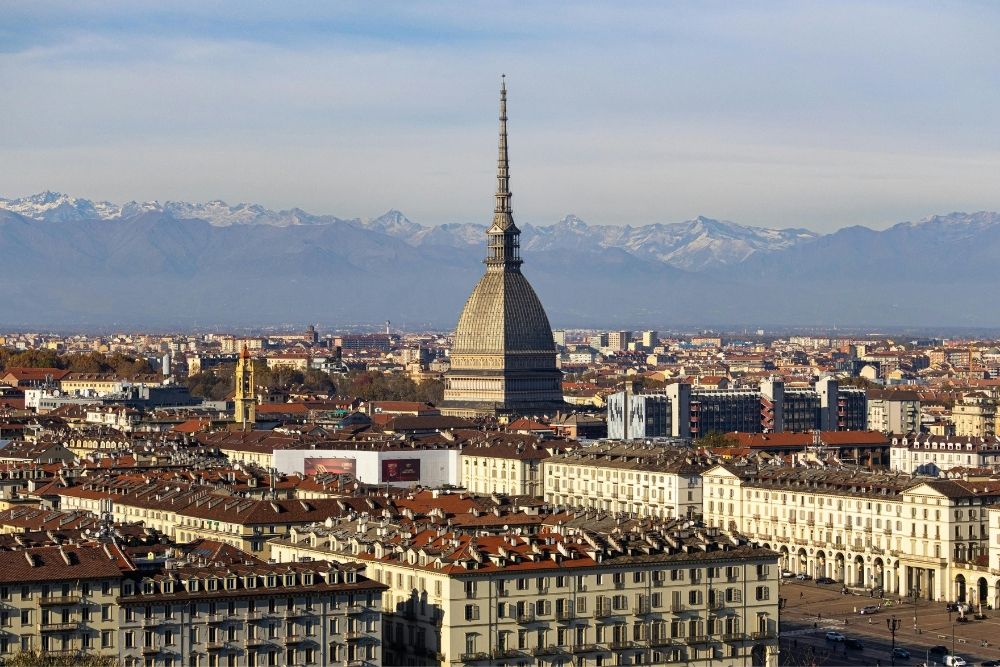
Province of Biella
The tiny province of Biella is located in the north of the region of Piedmont and covers an area of just under 200 sq. km. To the west it borders the region of Aosta, to the south west the province of Torino and the rest of the province is enclosed by the province of Vercelli.

Province of Biella, Piedmont
The whole province is surrounded by mountains with the Biella Alps to the north and west where the highest peak is Monte Mars at 2600 metres. There are cultivated plains in the south and east of the province where rice and corn are cultivated.
The capital city of the province is Biella with the second city being Cossato.
Other main towns in the province of Biella are:
- Vigliano Biellese
- Candelo
- Trivero
- Mongrando
- Valle Mosso
- Occhieppo Inferiore
- Ponderano
- Gagliancico
- Cavaglià
- Andorno Micca
Biella Province, located in the Piedmont region of northern Italy, is a place where natural beauty, history, and industry harmoniously blend. Nestled at the foot of the Alps, Biella is renowned for its centuries-old wool and textile industry, but it offers far more than just fine fabrics. With its picturesque landscapes, ancient sacred sites, and charming medieval villages, Biella is a hidden gem in Italy waiting to be explored. Whether you're an outdoor enthusiast, a history buff, or a lover of craftsmanship, Biella has something unique for every traveler.
A Brief History of Biella
The history of Biella dates back to the Roman era, when the town served as a strategic settlement in the foothills of the Alps. Throughout the Middle Ages, Biella became an important religious center, with numerous sanctuaries and monasteries built in the surrounding hills. The area was also shaped by the House of Savoy, the ruling dynasty of Piedmont, which left its mark on local architecture and culture.
However, it was in the 19th century that Biella truly flourished, becoming a global hub for the wool and textile industry. The region’s high-quality wool production attracted major investments, transforming Biella into Italy’s “wool capital.” Today, Biella remains synonymous with textile excellence, with many prestigious brands and manufacturers calling the province home.
The Wool and Textile Industry
Biella’s reputation as a world leader in textile production is deeply rooted in its natural resources and skilled craftsmanship. The nearby Alps provide an abundance of fresh water, which is essential for wool processing, while the cool climate ensures high-quality sheep farming.
Wool Processing in Biella
The province has been producing wool for over a thousand years, and its artisans have honed their techniques to perfection. The wool from Biella is known for its softness, durability, and luxurious feel. Many of Italy’s most prestigious fashion houses, including Ermenegildo Zegna and Loro Piana, have origins in Biella, and their products are crafted with wool sourced from this region.
Visitors to Biella can explore the history of the wool trade at The Wool Museum (Museo della Lana) in Miagliano, which showcases the province's rich textile heritage. You can also tour working textile factories to see firsthand how wool is processed, dyed, and woven into high-quality fabrics.
Sacred Sites and Religious Heritage
Biella is also known for its religious landmarks, particularly the Sacred Mount of Oropa (Sacro Monte di Oropa), which is one of the most important pilgrimage sites in Italy. Situated 1,200 meters above sea level in the Biellese Alps, the Oropa Sanctuary is dedicated to the Black Madonna, a venerated statue of the Virgin Mary that is said to possess miraculous powers.
Oropa Sanctuary
The Oropa Sanctuary, a UNESCO World Heritage site, is a breathtaking complex of chapels, basilicas, and pilgrimage routes. The Sacred Mount is part of a group of nine Sacri Monti in northern Italy, recognized for their spiritual and artistic significance. The sanctuary dates back to the 4th century, but the current structure was built between the 16th and 18th centuries. It is surrounded by stunning mountain scenery, offering visitors both spiritual enrichment and an opportunity to enjoy nature.
In addition to its religious significance, Oropa is an architectural masterpiece, featuring Baroque and Neoclassical elements, intricate frescoes, and impressive statues. Each year, thousands of pilgrims visit Oropa to pay their respects to the Black Madonna and participate in religious festivals, such as the Feast of the Assumption in August.
The Via Francigena
Biella also lies along the Via Francigena, the ancient pilgrimage route that stretches from Canterbury in England to Rome. Hikers and pilgrims often stop in Biella on their way to the Eternal City, taking in the serene landscapes and historical landmarks that dot the province.
Medieval Towns and Architectural Beauty
The province of Biella is home to a number of medieval towns and villages that have retained their charm over the centuries. These historic settlements, with their cobbled streets, ancient churches, and stone houses, offer a glimpse into the province's past.
Biella Piazzo
One of the most picturesque parts of the provincial capital is Biella Piazzo, the medieval quarter perched atop a hill overlooking the modern city. This historic district is accessible by a funicular railway and features narrow streets, stately mansions, and impressive palazzi that date back to the Middle Ages. Palazzo La Marmora and Palazzo Ferrero are two notable buildings, both offering guided tours that highlight the architectural and cultural history of the region.
Candelo
Another must-visit is the village of Candelo, home to the famous Ricetto di Candelo, a well-preserved medieval fortress. Built in the 14th century, the Ricetto was originally used to store agricultural produce and protect the local population during times of war. Today, its ancient towers and walls transport visitors back to the Middle Ages, making it one of the most evocative medieval sites in Piedmont. Candelo also hosts seasonal festivals and cultural events, such as the Rievocazione Storica, a medieval reenactment that draws crowds from across Italy.
Nature and Outdoor Activities
Biella's location at the foot of the Alps makes it an ideal destination for nature lovers and outdoor enthusiasts. The province is blessed with diverse landscapes, from rolling hills and lush valleys to rugged mountain peaks and pristine lakes. Whether you enjoy hiking, cycling, or simply relaxing in nature, Biella has plenty to offer.
Zegna Oasis
One of the highlights of the region is the Oasi Zegna, a vast natural reserve created by Ermenegildo Zegna, the founder of the Zegna textile empire. The oasis covers more than 100 square kilometers and is a haven for outdoor activities, including hiking, mountain biking, and skiing in the winter months. The panoramic Zegna Road (Panoramica Zegna) offers stunning views of the surrounding mountains and valleys, making it a popular route for scenic drives and cycling tours.
Lakes of Viverone and Mucrone
Biella is also home to beautiful lakes that offer tranquil escapes and recreational activities. Lake Viverone, the third-largest lake in Piedmont, is a popular spot for swimming, boating, and birdwatching. Meanwhile, Lake Mucrone, located near the Oropa Sanctuary, is a serene alpine lake that can be reached via hiking trails or a cable car. The area around Lake Mucrone is perfect for summer picnics and winter snowshoeing.
Culinary Traditions of Biella
Biella’s cuisine is deeply tied to its pastoral and agricultural traditions. The province’s dishes are hearty and flavorful, often featuring locally sourced ingredients like cheeses, meats, and mountain herbs.
Polenta Concia
One of Biella’s signature dishes is Polenta Concia, a rich and creamy version of polenta made with butter and local cheeses, such as Toma and Fontina. It’s the perfect comfort food for cold winter days in the mountains.
Supa 'd Pan e Vino
Another local specialty is Supa 'd Pan e Vino, a traditional soup made with bread, wine, and garlic, showcasing the simple yet satisfying flavors of the region’s peasant cuisine.
Cheeses and Wines
Biella is also known for its excellent cheeses, including Toma Biellese, a semi-soft cheese made from cow’s milk, and Maccagno, a mild and creamy cheese. The province produces high-quality wines as well, particularly Nebbiolo, which is grown in the nearby vineyards of Lessona and Bramaterra. These wines pair perfectly with the region’s robust dishes.
Festivals and Events in Biella
Biella hosts a variety of festivals and cultural events throughout the year, offering visitors a chance to experience the province’s rich traditions and lively community spirit.
Transumando Festival
One of the most unique festivals is the Transumando Festival, which celebrates the seasonal migration of sheep between the plains and the Alps. Held in the spring and autumn, the festival features traditional music, dancing, and a parade of sheep through the streets of Biella.
Biella Festival of Contemporary Art
For art lovers, the Biella Festival of Contemporary Art is an annual event that showcases cutting-edge works by Italian and international artists. The festival transforms the streets and piazzas of Biella into an open-air gallery, with installations, sculptures, and performances taking place across the city.
Conclusion: A Province of Tradition, Nature, and Industry
Biella Province is a fascinating destination that offers a unique blend of natural beauty, historical significance, and industrial heritage. Whether you’re exploring its medieval towns, hiking in the Alps, visiting sacred sites, or learning about the province’s wool tradition, Biella provides an authentic Italian experience that is rich in culture and charm. For travelers looking to step off the beaten path and discover the hidden gems of northern Italy, Biella is a destination worth exploring.







